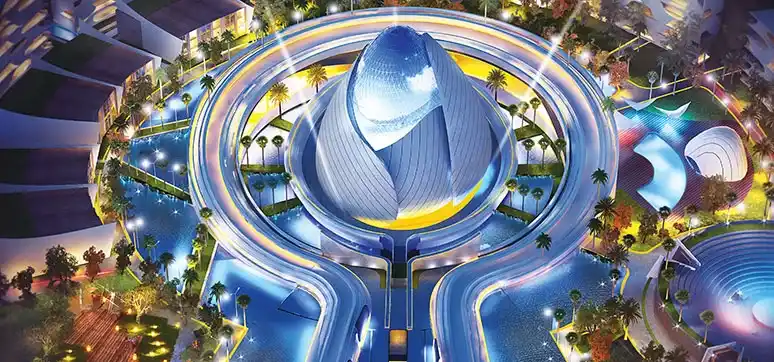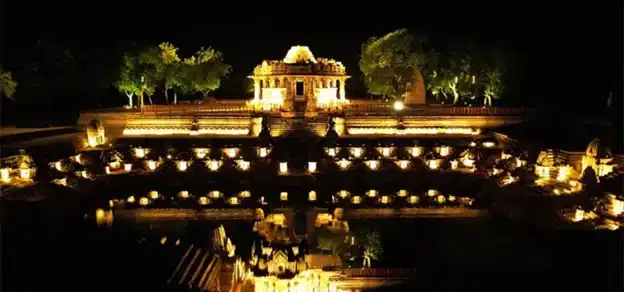A building’s façade is an expressive feature. Perhaps the only visible design element to the non-inhabitants is the façade. Creatively illuminated building façades convey messages, communicate emotions, create attention and facilitate orientation. Moreover, modern lighting solutions for building façades add value to the architectural or economic merit by making a location more prominent, beautiful and safer. Achieving the status of ‘iconic and attractive nightscapes’ demands great aesthetic design sensibility.
Lighting solutions also need to be sustainable, save resources and prevent unnecessary light pollution. A building is in constant dialogue with its ecosystem, and for it to be sustainable, an efficient system of façade lighting is imperative. Saving energy is an omnipresent challenge. Façade lighting must, therefore, get to grips with ecological compatibility issues.

The number of buildings that have illuminated façades is increasing sharply. Because of architectural, societal and technological changes, lighting design faces new challenges. The cover story discusses façade lighting – from a designer’s standpoint as well as from a lighting system manufacturer’s point of view – as an energy-efficient and iconic design solution.
Importance Of Facade Lighting: Complimenting Building Exteriors

Façade design itself is approached in two distinct ways – one, the façade is simply a derivation of the plan. And two, it is developed as a separate design exercise and has little to do with how the building is actually laid out internally. In the latter case, the form is usually stressed more.

Both the cases have the potential to make for very engaging and striking nighttime façades, observes Harmeet Singh Issar, Founding Partner and design Director, of Design Matrix. It may seek to integrate with the architecture and simply highlight the elements – ‘façade for light’; or it may serve to create a distinct identity and seemingly transform the façade by night, yet obviously dovetail into the architecture – ‘light for façade’.

Indeed, lighting does much more than bring out every curve and crevice of the façade; it imparts a personality to the building and structure. The façade is the first feature to be noticed about any structure and it is the preamble to an architect’s work. It is the responsibility of the lighting designer to pick the right architectural elements, understand the architect’s story and enliven the character of the structure at night, points out Aditi Aneja, Head of Lighting Design and Specifications, Cinmar Lighting Systems, UAE.

The façade lighting not only helps to localize buildings and provide security, but it also plays a key role in the architectural expression. The elements of the building, where an architect and structural engineers have put up a lot of effort to make it a benchmark have to be highlighted as one of the most prominent elements of the structure, thus appropriate lighting can complement its exterior, says Sushant Surve, Principal designer, Brainwave Designs & Associate.

Debmalya Guha, Principal Architect and Planner, Pace Consultants, adds that a creatively illuminated building can make the most memorable impression as it gleams far and wide in the darkness of the night.
According to Indrajit S. Kembhavi, Principal Architect, Kembhavi Architecture Foundation, façade lighting adds aura and identity not only to a building but also to the cityscape and skyline. It enhances and expands the expression of the façade. It presents multitudes of aspects and dimensions to the façade from static to dynamic, he adds.
Whether it is day or night lighting, lights usually help pull attention to texture, shapes, spaces and colours, assisting the architecture in attaining its purpose. Vision is the single most key sense through which we relish architecture, and lighting enhances the way we perceive architecture even more, points out Shabbir Kanchwala, Senior Vice President, K Raheja Corp.
Ar. Prem Nath, Founder, of Prem Nath & Associates agrees that both daylighting and artificial lighting draw attention to textures, colours, and forms of space, helping architecture achieve its true purpose. “Buildings can be turned into genuine landmarks. The façade lighting plays a key role in the architectural expression. To match the different finishes on the exterior of a building (be it glass, zinc, stone or metal), along with different colours, finishes and types of materials, outdoor lighting fixtures are fixed in order to complement them all”, says Ar. Prem Nath.
The blending of exterior façade lighting with interior functional lighting should be done by analysing the type and size of fenestrations in the façade, and fenestration, in turn, needs to be carefully placed depending on the climatic conditions of the area and the specific function for which the building is designed, points out Prof. Charanjit Singh Shah, Founding Principal, Creative Group. Along with making the building safe and easier to approach during nighttime, it enhances the architectural expression and emphasises its design features, natural shapes and surface structures.
The building at the same time, should not contribute to light pollution, a condition where excessive artificial lighting during nighttime disturbs the natural habitat of the nocturnal species, adds Prof. Shah. According to A-Project-by-Pace-Consultants, façade lighting plays a major role as it enhances the elevation in the interior or the exterior of the building. It emphasises the architecture, and the structure, and attracts attention.
Also, the various lighting makes the experience transform the architecture and mood of the building. Nowadays, through lighting, one can communicate messages, and convey information. It helps in the promotion of the economy & tourism, sustainable lighting and security aspects are also some factors that add on to the marketing factor.
Apart from emphasising artistic expression, façade lighting should also contribute to the branding and marketing for the investors, landmarking for the city planners, ensuring sustainability for the environment and lastly, imparting a “local essence” to the structure. It also attracts tourists, employees and customers as may be the purpose of the structure, adds Aneja. Only monuments that had a lot of ornamentation such as historic buildings and palaces used to enjoy grand lighting schemes earlier, points out Pavitra Sriprakash, Architect, Shilpa Architects.
Today, however, a lot more contemporary architectural forms enjoy dramatic lighting details that almost play with the light and shade to create visual impressions that are not merely ‘illuminating’ the façade – but are actually becoming a part of the architectural interplay between form and light. Light filtering through trellises and transparent surfaces, colour changing façades of different moods, accent lights that form narrow beams and patterns on the surface – all of these are possibilities for architects and designers today.

According to Radeesh Shetty, Lighting Designer and director, of The Purple Turtles, façade lighting has a classical version, which lights the building in a conventional way, and a modern hi-tech version, which allows the use of dynamic lighting to create video walls and even render a 3D impression on the building. By emphasising the architectural form, façade lighting makes a building more vibrant and attractive.
Ar. Prem Nath explained the unique lighting effects that can create a 3D impression, and give buildings their own character, making them popular attractions in the cityscape, both day and night. Intelligent sensors and controllers enable the systems to adapt to daylight brightness levels and create a lasting impression in all weathers; this totally compliments the façades of the building.
Role of Façade Lighting
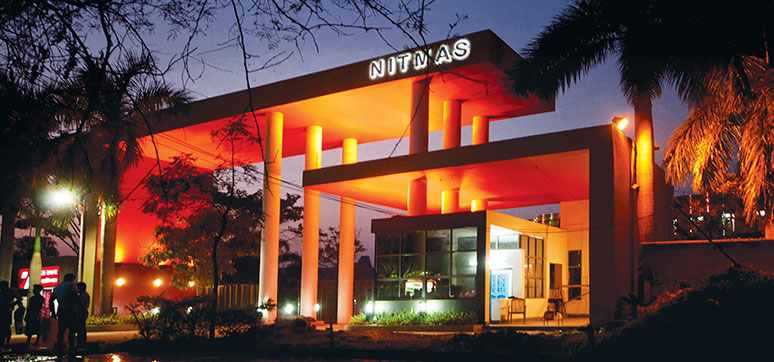
• Façade lighting plays an important role in the way people experience
and understand architecture.
• Whether buildings and structures are lit naturally or artificially, lighting is the medium that allows us to see and appreciate the beauty in the buildings around us.
• Lighting can bring an emotional value to architecture – it helps create an experience for those who occupy the space.
• Light draws attention to textures, colours, and forms of space, helping architecture achieve its true purpose.
• Enhancing the night image of important functional or architectural significance.
• Providing vertical illuminance in the adjacent area to reduce contrast with the pedestrian lighting and to reduce shadows.
• Provide visual cues to assist people’s orientation at night.
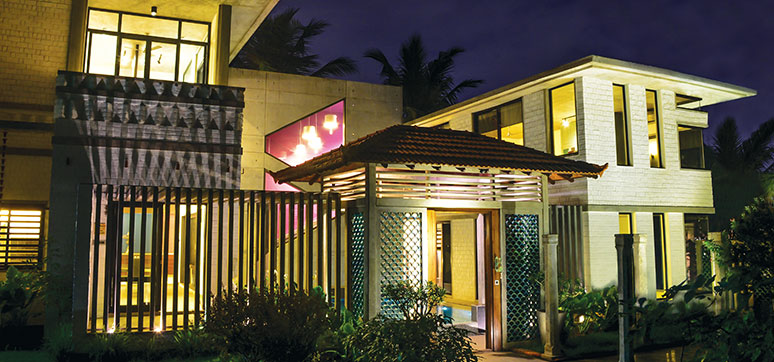
• Highlighting or decorative lighting shall be designed to avoid excessive energy usage and shall use high-efficiency light sources consistent with the other external lighting.
• Where highlighting of buildings does not serve a dual purpose of public lighting, the lighting shall automatically switch off at midnight.
(Sandeep Adagale, Lighting Design Director, Lighting Dimensions Studio)
Lighting Options
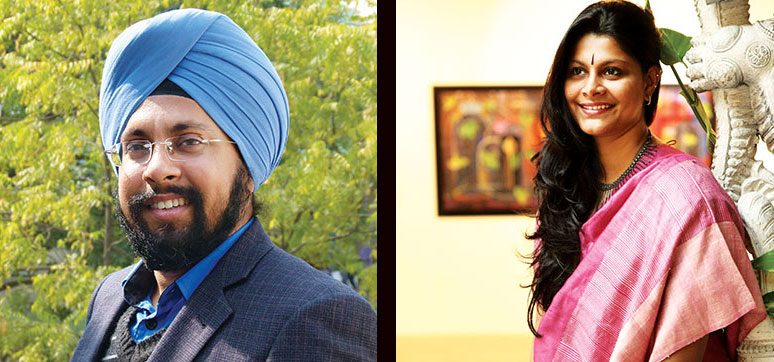
Façade illumination, notes Sandeep Adagale, Lighting Design Director, Lighting Dimensions Studio, is the process of unfolding the architectural elements through the various layering of light. A façade’s form appears different, based on the light that falls on it, its direction and its colour. The appearance of a façade alters during the course of the day due to the changing direction of light, and the varying components of diffused and direct light.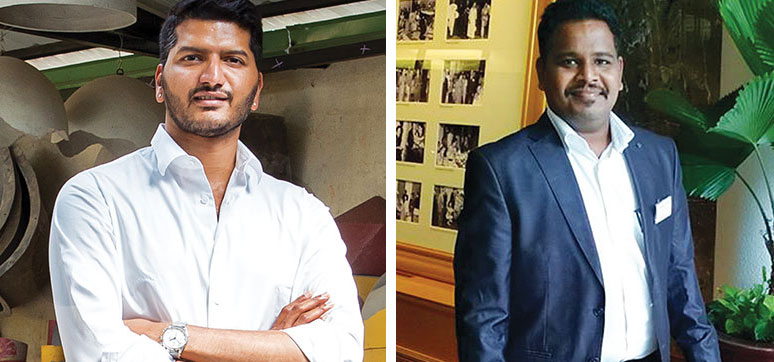
Direct lighting: Lighting where more than 90 per cent of the light goes directly from the source to the area you wish to illuminate. Directed light: Light produced by point surfaces, which results in a concentrated output that accentuates edges and shadows. Directed light normally causes glare when the source is viewed directly.
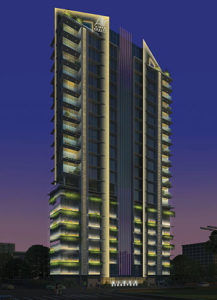
Up-lighting: Lighting method where an object or surface is lit from below, with a luminaire that directs its output upward. Wall grazing: Lighting effect where a wall with an irregular surface is illuminated so that there are both highlighted and shaded areas. This effect is only possible on walls with granular surfaces, such as those built from stone or exposed brick. The opposite effect is wall washing.
Wall washing: A lighting effect, where a wall is illuminated so that surface irregularities are minimized, it seems smoother. The opposite effect is wall grazing. The simplest form of architectural façade lighting is the up-lighting of classical architectural elements, explains Sriprakash. This is particularly interesting when there are many windows or columns that can be simply lit for an elegant and somewhat predictable but timeless look for any classically designed building. The other play of light which is interesting instead of the typical wall washing or up lighting technique is, of course, the use of LED which are dynamic and keep changing – whether it is their shape, the colour or the beam of light that they throw onto a façade.
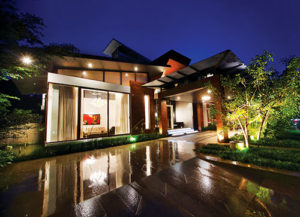
Façade lighting works cohesively with the architecture to highlight its best features. According to Shetty, uniform vertical lighting accentuates the building façade without altering its form. While focused lighting draws attention to distinctive architectural features on a building façade. Contour lighting illuminates and differentiates the foreground from the background of a building. Creative lighting patterns can be used to make an emotional connection with the building, in a way that it amplifies its cultural value on the façade. Interactive LED lighting systems merge rear projection and motion tracking technology that turn a façade into a two-way communicative medium, adds Shetty.
In addition to the said type of lighting, Ar. Prem Nath spoke about media façades. “Today, we have permanent media façade installations worldwide that call for attention. With size, tempo, colour and brightness they stand up as individuals within the urban nightscape. Like a good book requires a storyteller, media façades demand the architect’s innovation to arrange exciting stories that fit into the site and suit the client. It’s totally how the lighting solution is used/placed in order to create a great impact”, he explains.
Methods Of Facade Lighting
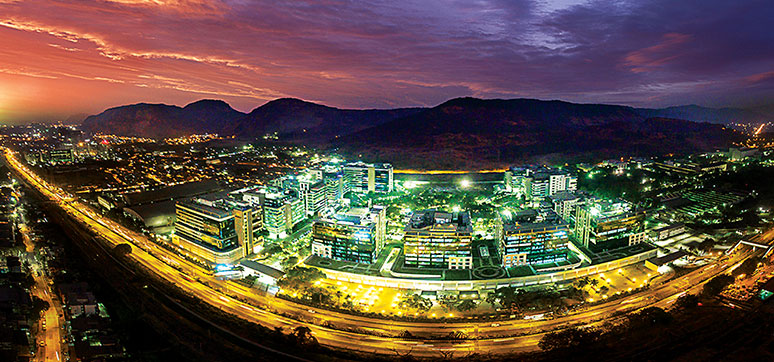
Myriad solutions are possible with the advent of smart façades and state-of-the-art lighting systems, says Aneja. “After determining the goal of lighting, I suggest a two-pronged approach to finalise a solution: first is to study the façade and second is to apply the right technique”, she points out. Silhouetting, layering, grazing, contrasting and highlighting are some techniques. Apart from these, subtle play with beam angles, intensities, colours and dynamic lighting adds rhythm to façades.
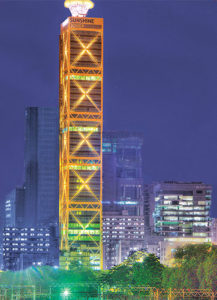
Issar talks about Three Broad Types of Façade Lighting:
1. Architectural Façade Lighting: Light is applied to enhance the structural and architectural details – light is there for the façade, as per the façade. Successful lighting design is, however, dependent on effective collaboration between teams to ensure that light sources are integrated within the architecture so that the effect is showcased rather than the fixture.
2. Pixelated Façade Lighting: These have been made better with the advent of solid state lighting. They use the architecture as a blank canvas to paint an entirely different nighttime picture message or identity. These façades offer greater opportunities for the engagement of the public as they are often interactive or can be easily made interactive.
3. Projected Façade Lighting: While projected façade lighting is dynamic, its huge advantage lies in the fact that it can easily be done later or changed later. However, due to the nature and cost of equipment, they are more popular as temporary or event-based applications.
According to Surve, the illumination of the façade should be done by keeping an eye on the surfaces, materials and the degree of reflectance. The step to basic illumination of a façade is normally executed by breaking into simple shapes to which a uniform illumination is applied and accent lighting is used in order to emphasise a particular element.
The façade lighting approach initiates with the following: type of building (corporate office, hospitality, residential towers, malls, worship centers), solid façade, vertical façades, horizontal façades, façade with projecting or recessed sections, perforated façade, banded façade, and transparent façade.
The Glitter Effect
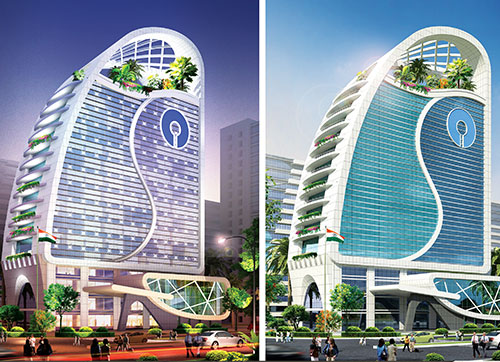
The State Bank of India, local head office at the Gift City Gujarat: The ground plus 13 upper floor structure is designed in an iconic fashion. The visual appeal of the building is through its linear and symmetrical form. The building structure is aesthetically designed in a way that the service core is planned towards the western side of the building.
The office space makes maximum use of natural daylight and outside view. The architects, Prem Nath & Associates, have used spotlights on the glass façade to create a glitter effect, which is quite attractive for the public space during the night.
Adding layers and patterns of light to a flat solid façade will give dimension to the façade while a perforated façade is best silhouetted with backlighting and best contrasted with brightly lit windows and other openings from the inside.
For solid façades, generally, the approach is to wash the building uniformly, whereas on perforated façade, illuminating the window accentuates the frame of the façade opening, whereas narrow-beam uplights emphasise the façade‘s grid pattern.
However, good design practices need to be followed to avoid any glare or discomfort to the functioning indoors. Varying light intensities, distribution patterns and colours are a great way to light façades with projections or recesses. Façades with vertical breaks can be augmented by using narrow beams of light while adding lines of light on every floor ceiling breaks the monotony, says Aneja.
On vertical façades, adds Surve, floodlights produce uniform illumination. Washlighting with point-shaped light sources is suitable for horizontal façades since the surface texture and structure will be clearly visible, accentuating the columns from the surrounding façade. Uplights positioned on two sides emphasise the volume of the column.
Façades with horizontal breaks cast strong, short shadows and this can be prevented by projecting light at steeper incidence angles by luminaires placed at a greater offset, points Aneja. For horizontal façades, Surve advice floodlights to illuminate the entire façade and to emphasise the horizontal divisions by casting heavy shadows. Indoor users should not be dazzled. For banded façades, illuminating the indoor areas at night forms a strong contrast between dark façade surfaces and a bright strip of windows.
Lighting transparent façades can be tricky as no spill light should impair any activities in the interior of the building. Bright indoors with down-lighting is preferable as this gives the illusion of a more spaced-out upper structure for a viewer from outside. Uplights emphasise the vertical elements of the façade in the case of transparent façades. Façade lighting is not a problem that needs a “solution”, rather it needs a creative approach to visualise a soothing yet appealing design that does not guzzle energy or cause night-sky pollution, observes Guha.
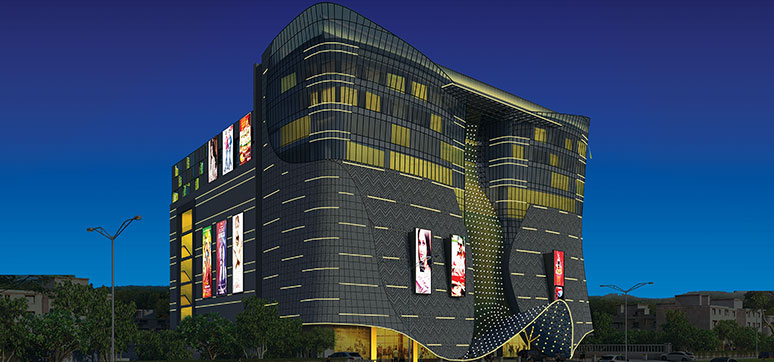
When deciding on the right lighting concept for any architecture, says Kanchwala, the design and usage of the construction play a critical role. Façade lighting creates added cultural worth. External lighting of historical buildings, for example, must highlight the structural elements, such as mouldings, cornices and reliefs, without altering their perception. The correct lighting can add value, expressing the architectural importance to reflect a positive image.
According to Ar. Shah, if lighting deals sensitively with architecture, the character of a façade remains the same, day or night. Uniform, wide-area illumination of a façade reveals its natural shapes and surface structures. While the building’s appearance is preserved, the architecture speaks for itself. Using white light to pick out individual columns, ornaments or projections in the darkness is another very popular option. Different rules apply at night. If characteristics, contours or structures can be identified, this creates an impression of three-dimensionality.
A professional lighting concept lends a building special flair. Taking the environment of a building into account as a design element in its own right results in a high degree of naturalness.
Effects On Environment
Light pollution is a major issue and in today’s age the sustainability factor needs to be balanced with the ‘wow factor’, says Sriprakash. Improperly used night-time lighting can hurt the environment.
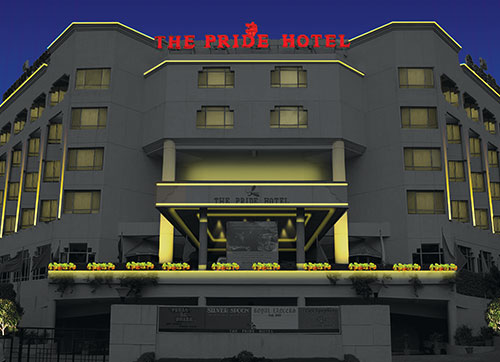
Such lighting disrupts the biological processes of creatures that are sensitive to light. Disrupting the sleeping patterns of nocturnal animals is an absolute no-go, and architects need to be sensitive to the angles of illumination they choose to adopt. Stray light that shines into the sky consumes unnecessary energy and adds to light pollution, which is exacerbated by excessive, misdirected or obtrusive uses of light.
Prof. Shah observes that a sky glow occurs when artificial light which shines upwards, reflects off clouds and atmospheric particles such as dust and water, causing a ‘scattering’ effect. Too much light is a sign of poor design skills, points out Guha. One should try to use the optimum amount of light in the right temperature, and selectively accentuate distinctive features of the building, thus creating a fascinating design.
According to Sriprakash, other than the light pollution, the major aspect is the interference with the building occupants – very often inside commercial buildings – is the glare coming into the workspace from façade lights which may not be properly planned. This disrupts the working conditions within the building Using luminaires with high efficacy, avoiding light pollution and trespass, using technologies that are reliable and proper planning of the location of drivers and their access, all contribute towards a successful, sustainable façade lighting design, adding Issar. According to Prof.
Shah, façade lighting can be made sustainable by using the Building Management System (BMS) which allows for timers, dimmers and luminosity regulation, enhancing controlled visual impact as the night falls. The façade lighting should not disturb the environment but instead complement it.
Checkpoints
Guha articulated the many options for light fixtures, light colours and controls, which are flooding the market that is completely drowning the fine art of illumination design. “Over-lit façades with jarring colours are becoming too common creating a jarring nightscape of the cities. ‘Façade lighting solutions’ are being provided by suppliers who are more often interested in using more than the required number of fixtures creating illuminated disasters at exorbitant cost”, he adds.
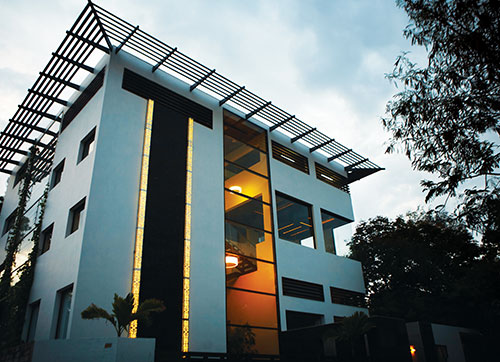
The lighting design must be context-appropriate, says Issar. This implies that it must suit the style of architecture, the building typology, the location and setting as well as client aspiration and budget. Ease of access and minimal maintenance are usually very crucial features of successful façade lighting. Since it involves installing and accessing lights in hard-to-reach places, the technology and quality of the luminaire must be robust. It serves as a strong marketing tool and the conveyor of the brand image.
A single luminaire going wrong can be very visually disturbing and reflects badly on the brand. One aspect that is often an afterthought in the façade lighting design is the placement of the drivers on the façade which is an extremely critical part of the design.
According to Kembhavi, material typology, uniformity/ diversity, maintenance, efficiency, environment and responsibility, purpose and function, and opex and capex are the various criteria to look at while lighting the façades.
Light Pollution is Excessive and Inappropriate Artificial Light.
• Light Trespass: light falling where it is not intended, wanted or needed.
• Glare: excessive brightness which causes visual discomfort. High levels of glare can decrease visibility
• Clutter: bright, confusing, and excessive groupings of light sources, commonly found in over-lit urban areas. The proliferation of clutter contributes to the urban sky glow, trespass, and glare
Broadly, three types of checks should be made, says Aneja.
1. Façade Check: Material, length and breadth to be illuminated, façade strength to hold the lighting fixture, fixing mechanisms possible, and access to luminaires for maintenance should be evaluated.
2. Environment Check: Temperature (highs/ lows), humidity, etc. determine the rating of the cables, luminaires and drivers. Weather conditions like snow, rain, sandstorms, etc. also determine the temperature rating, wind resistance, IK rating, IP rating, material as well and electrical characteristics of the luminaire.
3. Product Check: Glare control, correct aiming, lenses, right shielding accessories (louvers, gobos, etc.), proper luminaire placement and correct lighting calculation will provide visual comfort to nearby and distant viewers.
Aneja mentions checking colour quality too. A basic check on the CRI rating is a good idea and for façade lighting, there is no need to go into CRI extended values. Also, colour temperature plays an important role; with preference of warmer colours in colder regions and cooler tones in hot and tropical regions.
The checkpoints according to Suvre and Kanchwala are, the category or usage of the building, design and environment, type of façade material, light source, vandal resistant, maintenance-friendly, minimum light pollution, dynamic lighting, light management systems, uniformity of lighting, power-saving and environment friendly.
Adagale Explains some of the Above-Mentioned Checkpoints:
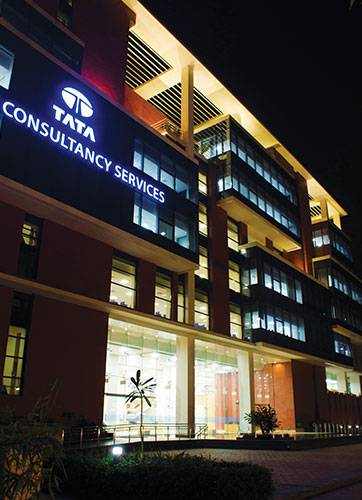
• Selection of Material for Outdoor Fittings: Based upon surrounding conditions, we prefer high-pressure die-cast aluminium with very low percentage copper content with superior grade powder coating or 316L stainless steel housing.
• Ingress Protection Rating (IP rating): IP rating stands for international protection rating and classifies the degrees of protection provided against the intrusion of both solid objects and water in electrical enclosures. We Prefer to use all products above the IP65 rating.
• The Efficiency of Lighting: To achieve an energy-efficient solution, one must calculate how much lumens of light per watt of electricity the lighting system delivers.
• Colour Temperature: The Correlated Colour Temperature (CCT) describes the colour output of the lamp itself. It varies from 2700K (warm), 3000K (warm white), 4000K (neutral white), and 6000 K (white).
• Types of Light Source: Nowadays we recommend only LED with its new technology provides you with a long-lasting solution and minimal maintenance.
• Glare Control: Visual comfort is important for the users and their surroundings. The glare may be visible from nearby or distant areas but can be minimised through good design practices.
• Light Pollution: Light pollution can be described as artificial light allowed to illuminate areas not intended to be lit. Make sure the lighting plan is good and the selections of products are well-suited and aimed at the correct area.
Adding to the above-mentioned points, Shetty suggests that the lighting fixtures installed on the exterior walls should be lighter in weight and made of material that helps it to withstand varied weather conditions, thereby ensuring it’s long-lasting and energy-efficient. Installing light management systems such as motion detectors and daylight control will ensure safety and cost efficiency.
Installing façade lighting fixtures at accessible points makes it easier for maintenance and repair.
Light Sources :
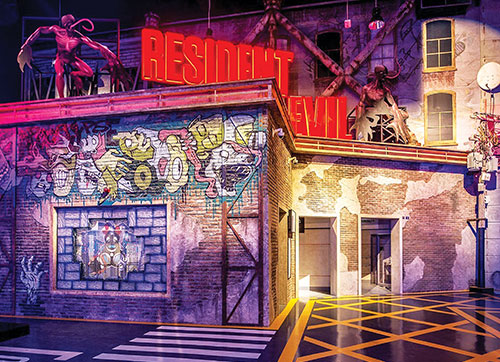
Metal halide and high-pressure sodium light sources, though tried and tested, are now extinct. LED lighting “systems” with complete light control and management is trending. LED video screens, and media façades are the latest in line, says Aneja. Agreeing with her, Kanchwala adds that the revolutionary development of LEDs has opened up fresh design approaches for façade lighting.
The controllability of the brightness and light colour of LED light sources, together with their diverse optical characteristics, are making innovative technical lighting solutions possible. A poorly designed LED lighting product can lead to faster overheating, faster lumen depreciation, light discolouration, and a much shorter life of the lamp.
Though not new, another light source worth mentioning is “fibre optics”! The maintenance personnel only need to access the control room where the light source is housed and not the façade; this is a very safe solution for tall structures. Ar. Shah says that the ETFE Multifunctional Module aspires to enhance the use of BIPV in the construction industry, providing new architectural façade lighting possibilities. It demonstrates the multiple uses of ETFE architecture, showing it as a versatile material with potentially wide applications.
Standards, Local Norms & Regulations For Outdoor Lighting
The Energy Conservation Building Code (ECBC 2017) talks about energy efficiency in outdoor lighting and reduction in lighting power density to increase energy efficiency, notes Kanchwala. The National Lighting Code (NLC) published by the Bureau of Indian Standards has been formulated to set out in a convenient form the requirements for responsible social, commercial and engineering conduct for the designers, manufacturers and suppliers of lighting.
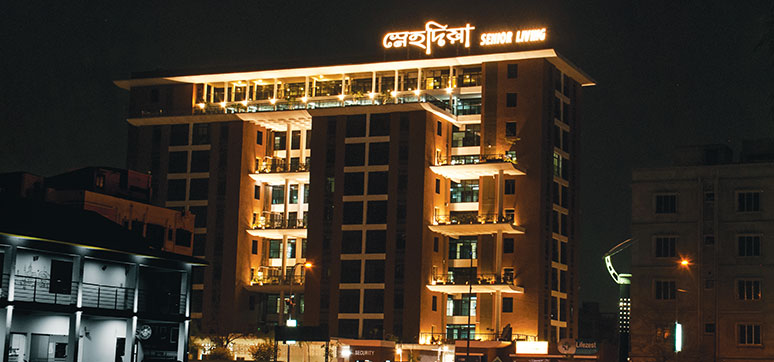
ANSI/ASHRAE/IESNA Standard 90.1 are some of the international codes that are frequently used for outdoor lighting designs. Right now the façade lighting norms don’t seem to be well defined as the industry in India is still in the infancy stage.
According to Adagale, the International Commission on Illumination (abbreviated as CIE from its French title) is an organisation devoted to international cooperation and the exchange of information among its member countries on all matters relating to the science and art of lighting. He talks about CIE 154:2003 maintenance of outdoor lighting systems. He also explains that the European Standards (EN) can be distinguished by content, which is decisive for the purpose of the use of terminology, basic, test, product standards, safety rules, procedures and standards of services, quality management standards, interface, interchangeability, etc. One can follow EN 12464-2 light and lighting for the lighting of outdoor workplaces.
In India, in the case of a heritage building, the approvals should come from ASI. Ar. Prem Nath, says that every aspect of the building, be façade/outdoor lights or the structure, has to be designed with the concern of the Urban Art Commission. Most state laws are limited to outdoor lighting fixtures installed on the grounds of a state building or facility or on a public roadway. The most common dark skies legislation requires the installation of shielded light fixtures that emit light only downward.
Replacement of unshielded with fully shielded lighting units often allows for the use of a lower-wattage bulb, resulting in energy savings. Other laws require the use of low glare or low-wattage lighting, regulate the amount of time that certain lighting can be used, and incorporate Illuminating Engineering Society (IES) guidelines into state regulations. According to Sriprakash, some cities in India have processes that restrict the usage of advertising and LED screens on the façades.
In general, norms and regulations are centred around safety when it comes to outdoor illumination or energy.
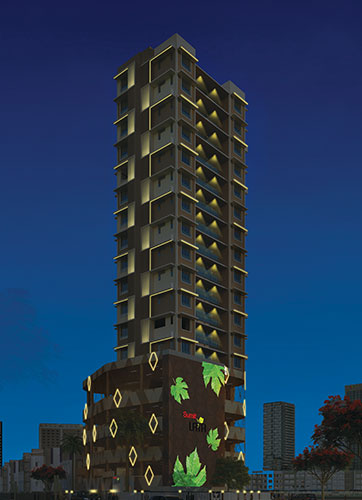
When it comes to façade lighting, there are some regulations on the types of fixtures that are allowed – cut-off fixtures that do not travel upwards into the sky are usually preferred. The energy conservation and lighting loads are also a factor in understanding how much we can afford to ‘spend’ on façade lighting.“In the UAE, we follow the ADM Abu Dhabi municipality manual, Dubai municipality compliance guidelines and estidama regulations”, says Aneja. Many private projects need clearance from local authorities. For more general compliance, one can refer to CIE and BS standards, though the local gulf standards are more rigid as they take into account the harsh weather conditions and proximity of the sea. Light pollution and sustainability are taken very seriously in these standards.
Impact Of Facade Material On Lighting :
The material is a large determinant for any lighting and will dictate the direction, amount and type of lighting the surface will receive. With smart façades and newer composite façade materials honing the market, lighting designers also have to upgrade to newer sustainable lighting technologies.
Studying the façade surface (flat or patterned) and its strength to hold fixations, light reflectivity, incident light dispersion properties, colour, and material composition – all these play a vital role in the selection of the lighting technique and the product, says Aneja. Every material behaves distinctly when illuminated, says Guha.
One needs to be aware of the right colour, temperature and intensity of light that is required to get the best visual effect. Too much light may create light burns, while too little may leave it illuminated. The material palette of future façades is evolving rapidly ranging from ceramics, multilayer aluminium/metal, to ETFE (ethylene tetrafluoroethylene copolymer) cushion fabric, multilayer ETICS (external thermal insulation cladding system) to green vegetated façade systems, adds Ar. Kembhavi.
Illuminating Glass Facades
Various types of glass façades have been in vogue, from translucent to twinkling with rainbow effect to reflective glass and optical illusion, observes Shetty. Glass façades encourage innovative ways to incorporate colours and even colour-changing systems in façade lighting that are customisable and attention-grabbing.
Also, there are glass façades with internal illumination that result in uninterrupted glass and light across façades, adds Shetty. Glass is a unique material that cannot be illuminated as light passes through it. It can have varying effects due to its reflectance, transparency and colour – just like water when hit with light.
One has to tread carefully when there is a glass façade as internal lights will be visible through the glass and interfere with the façade illumination, points out Guha. The design skills of the architect help to decide on how to create a fascinating illumination design, merging the leaking lights of the glass façade area, etc. The façade illumination should not be disturbing the occupants of the building.
Backlighting or lighting from the inside to the outside is great for glass façades. It is visible on the outside and yet causes no glare in the indoors. A modification to backlighting can be made if pixel lighting is employed. This would make up a low-resolution or a high-resolution dynamic graphic screen! Sandwiched translucent glazing could be used effectively to generate interesting illumination through colour changing etc.
Opaque surfaces could be used in highlighting, contouring and accentuating, observes Kembhavi. For glass façades, says Issar, instead of lighting the façade, one can look at ways of lighting from the inside out – using indoor lighting to contribute towards the night-time image. A lot of dynamism may be derived from the variation in the interior lighting if left to the users/ tenants/occupants. Alternately, peripheral interior lighting may be taken care of by the developers/ owners for a well-composed, even façade lighting design.
According to Sriprakash, the opaquer the façade the more interesting the lighting play can be. Creating small recesses within the glass façade and housing light elements within them can create exciting visual effects on an otherwise simple façade. The use of opaque coloured glass in double skin façades can also create very exciting architecture which is simple yet makes a statement, she adds.
From basic spotlighting to glitter effect with LED can be used on glass façade to illuminate it, says Ar. Prem Nath. “Now you can also harness the LEDs embedded inside Glassiled to open up whole new dimensions for your creativity. The LEDs either monochrome or RGB are powered via a superefficient, transparent conductive layer,” he adds.
Latest Trends In Lighting Systems & Lighting Controls
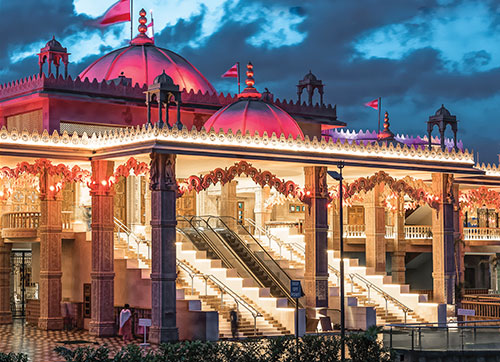
Smart and miniaturization are the keywords trending, observes Aneja. Lighting can now be controlled through phones, tablets or Alexa! This is due to the marriage between LED technology and AI. Many programming languages are written by façade lighting luminaire manufacturers. This makes for a complete package and a one-stop solution for the buyers.
Integration of data services, Wi-Fi along online surveying agencies will lead to seamless integration of all gadgets, and lighting will no longer be a separate entity and its use will not be limited to visual purposes. Surve spoke about indoor location tracking, camera-based lighting control, self-learning control systems, integrated street lights, healthier lighting, human-centric lighting, etc. as the latest entries in the field.
Architects are becoming increasingly aware of the cost savings and reduced energy consumption benefits of lighting control technology, including occupancy sensors that are most effective where there is constant traffic, timed switches based on elapsed time or programmed according to specific schedules, dimming controls, or a combination of these options, observes Ar. Prem Nath.
While opting for façade lighting, people go for options that have more lighting controls, such as user-friendliness and adaptability, energy efficiency, and good-quality light to help save energy, says Kanchwala. The need for efficient lighting and power saving is also driving advances in occupancy sensors and larger scale fluorescent control systems.
Recently, self-adjusting, adaptive controls have replaced manual dials and eliminated multiple trips to fine-tune sensor settings in a large environment. Talking about the commercial market, there is an increased demand to integrate dimming and switch functions with occupancy sensors and time controls into a single, whole-building lighting solution. A wholly incorporated framework offers productivity, upgraded life, well-being and security, and the energy savings inherent in lighting controls, adds Kanchwala.
Shetty also spoke about motion sensors, programmed switches and dimmable controls, which facilitate cost savings and reduced energy consumption while meeting the requirement. Self adjusting adaptive controls and wireless systems are replacing manual sensor settings in advanced technology.
Integrated lighting systems are in demand as they facilitate security and safety along with energy savings. The façade lighting industry is growing by leaps and ranging from dynamic to virtual reality through a screen, throwing out information/stories using it as a medium of advertising/display/ positioning, notes Kembhavi.
From a control perspective, it could be fused seamlessly to varied functions of the building through BMS/IOT. Façades could also be responsive, and informative and help in collecting mass data. Pavitra Sriprakash adds that in dynamic lighting, different areas and features can be individually controlled, based on different scenarios like a changing rhythm based on the time of day. These can be used to create various aesthetic scenarios or can adapt to the usage patterns of the occupants within the space.
Through this type of automation, smart usage of the lighting can evolve balancing the energy usage, the aesthetic and the programmatic needs.
Latest in LED Lighting
Economical controllability: Ensuring dimming performance in fluorescent and high-intensity discharge (HID) luminaries typically required a dimmable ballast that imposed a cost premium. Today, dimmable LED luminaires are available at price points that are competitive with standard ON/OFF and bi-level luminaires.
Intelligent lighting: The majority of LED luminaries are dimmable. When evaluating a control solution, one must always ask what method or protocol the devices use to communicate. The most common method is 0-10V. As LED sources are digital devices, however, they are readily compatible with digital controls. This has created significant opportunities for intelligent LED lighting that offers an extensive array of features.
Wireless technology: Wireless sensors and LED lighting, both luminaries and lamps, are now widely available. This extends applications, facilitates the adoption of intelligent lighting, and can make retrofits involving more sophisticated control schemes easier to implement.
Colour tuning: A growing number of LED products allow control of the shade of white light output, from full-range white light colour temperature modulation to dim-to-warm control. This has opened new applications for LED lighting, but with extraordinary potential as interest grows in the relationship between lighting and health. (Sandeep Adagale, Lighting Design Director, Lighting Dimensions Studio)
Use Of Facade Lighting As A Marketing Factor
Contemporary lighting solutions for building façades need to create added value for local authorities or should have architectural or economic merit by making a location more beautiful and safer, showing a building off in the right light or getting a positive corporate image across. The lighting shall not only generate revenue for the owners and inhabitants but also do a job of word of mouth as an intense marketing tool for the building, points out Surve.
Kanchwala too observes that façade lighting shapes the image of a townscape, and attracts attention from large numbers of customers. This boosts revenues and enhances prestige. Lights on a façade are visible to motorists far and wide. Visual memory is more lasting. Façade lighting, says Aneja, is a great way to convey a message, to display the vision of a city, to build a brand.
The display of the logo of a corporation is enough to mark its headquarters. It attracts employees and customers. Lighting on a façade for a developer may make or break his image. This also helps the developer attract investors. The hospitality industry makes the most of façade lighting which makes it attractive for customers and tourists.
Façade lighting not only enhances the value/glamour of a city but also acts as large billboards shouting out outdoing each other observes Ar. Kembhavi. Adagale adds that façade lighting creates added cultural value. Animated façades of today are used as ambassadors. Many of them even support interaction. A media façade is in harmony with its setting if it embraces both the architecture and the people who live in its immediately adjacent space.
Public acceptance is greater if a media façade is not perceived as out of place. According to Ar. Prem Nath, LED kinetic lights are highly impacted and dynamic in movement. Façade lighting design can be customised to complement a brand’s aesthetic value expressed in its external architectural design.
By doing so, it reflects the brand’s image on the outside, which also blends with the indoor design, explains Shetty. Displaying marketing elements such as a brand logo and incorporating its colours in the façade lighting, lends the structure a voice to communicate with its audience and a personality that creates a visual experience. Thereby making the building identifiable by the brand loyalists while it also attracts and inspires others.
Façade lighting on heritage buildings, bridges and monuments makes these structures appealing and draws tourists’ attention. Thereby, boosting the economy of the locality and enhancing its emotional and cultural value, adds Shetty.
Media Façades
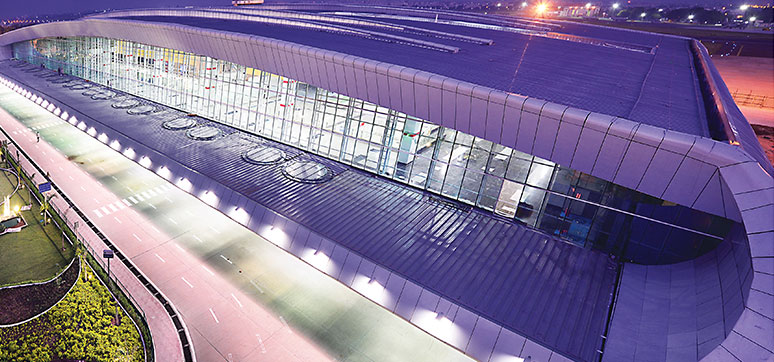
As technology advances, façade lighting is gradually following the trend of miniaturisation, points out Adagale. New trends include the media façade, which refers to a mode of lighting with the help of which light sources are integrated into the front face of a building. This lighting method borrows from the digital media format of displaying graphics, text and even video images on a building at night, visually transforming its façade after dark. This method is now being recognised as a new field of visual and spatial art that overcomes the structural limitations of rigid architecture.
It uses the colours of light to enhance the best features of the building. In short, the architecture of the façade is effectively used as a canvas to display media and digital art on a large scale. LED pixels arranged in a grid are often invisible during the day. They reveal their full capabilities only at night. The small points of light are individually controlled, like the pixels in a TV image. This creates images, videos, animations or extravagant colour patterns. Dramas of light staged in corporate colours create a highly memorable brand identity that is recognisable even from afar.
Media façades are increasingly recognised as one of the most exciting lighting technologies for creativity and design in contemporary architecture practice, observes Ar. Prem Nath. When designing media façades, opportunities to push the boundaries are myriad, encouraging lighting designers and architects to embrace this new ‘language’ and explore the use of light and media as façade ‘materials’ to form an integral part of an architectural vision. For this, graphic lights and kinetic lights are synchronised with spatial light animation and fibre optics.
Interactive façade is also quite trending – for instance, a robotic video camera randomly captures the surrounding landscape and people, which are then displayed in bitmap graphics onto the building façade; or a building façade that changes the colour distribution according to current weather conditions.
On Future Trends & Technologies In Facade Lighting
Professional façade lighting contributes a lot in adding glamour and beauty to various structures. It helps in highlighting the subtle features of the architecture without impairing them. The trends of façade lighting are ever-changing. The future will see light and architecture as one, with boundaries diffused, and surfaces and materials becoming luminescent, notes Issar.
Aneja anticipates the integration of lighting with the government’s security systems in the future. Many crimes and thefts can be prevented when lights from a façade signal to the police control room or security services are alerted when a citizen is in distress. Studying the traffic flow is another field where the lighting on façades can gather data and send it to a processing centre, she adds. Lighting on façades can act as a data routing medium from satellites. The possibilities are many and we are heading there very soon!
Ar. Kembhavi observes that the façade design is transiting from staid static to responsive dynamic, getting responsive and communicative to a situation/ environment. Future technologies would involve a façade that is self-cleaning and information-sensitive.
However, the biggest challenge shall be to balance the cost-to-performance ratio. Cutting-edge technological advancement is leading to the generation of façade design that is responsive to the environment changing dynamically with weather and seasons aligning with nature nurturing a green ambient environment and is constantly evolving.
Future façade can be defined as a fully responsive parametric façade that is nonstatic, but kinetic addressing varied issues including sustainability, power generation, and vertical farming and is informative and transformational, adds Kembhavi. Surve and Adgale predict that ‘Projection Mapping’ is going to be in demand in the future. At present, the know-how is limited, there are very few manufacturers, the cost is exorbitantly very high, the equipment is very large and needs lots of space for the installation and so on, says Suvre.
Adagale foresees that projection mapping (the process of projecting an image or video on the contours of a façade to create stunning effects) and GOBO projection can be seen in the façades of the future. GOBO stands for “Go Between”. It is basically a stencil or a cutout that is placed in between the lamp and the area to be lit. It results in artistic shadow and light effects creating stunning effects.
According to Shetty, a technology that facilitates smart lighting management will become a routine feature in all outdoor lighting designs in the near future. The smart-home technology will become widely preferred with the growth of automated control-based sensors and machine-learning technology. Using façade lighting to communicate with the audience through text, images and animations projected on controllable LED pixels on the façade will become a bigger and more enriched marketing medium.
CONCLUSION :
Illuminated façades facilitate orientation, convey messages, communicate emotions and create attention. Contemporary lighting solutions for building façades need to create added value for clients/owners/builders/ local authorities and they should deliver architectural and economic merit by making a location more beautiful and safer, showing a building off in the right light or getting a positive image across. Nowadays, lighting solutions also need to be sustainable, energy/resource-conserving and prevent unnecessary light pollution.
A creatively illuminated building becomes a landmark and markets itself without any extra effort and it helps in branding too. Cutting-edge technological advancement will lead the façades of the future to a different level, as a communicating visual experience. Achieving these goals demands great aesthetic design sensibility.
